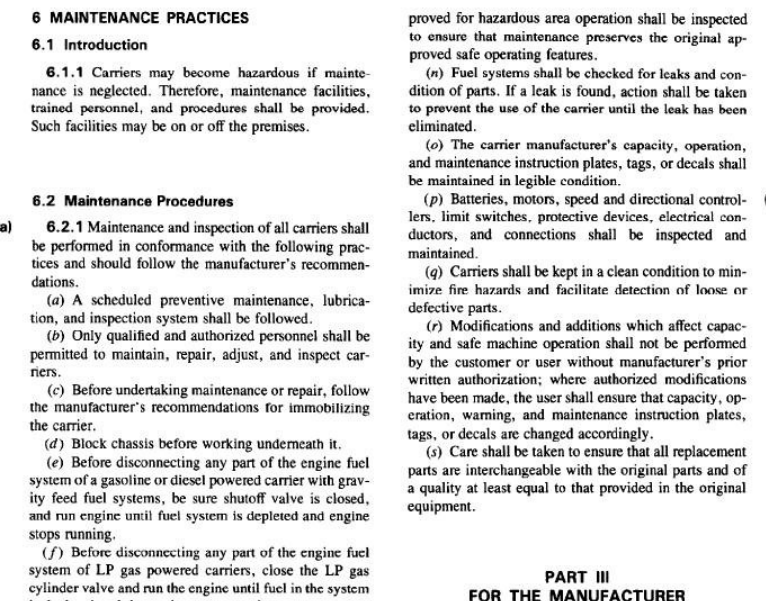ASME B56.8:1993 pdf free download Safety Standard for Personnel and Burden Carriers
(4 The manufacturer’s specified maximum mate-rial load shall be designated as the test load, placed onthe load bed of the carrier, and secured thereto such thatits center of gravity is directly above the geometric cen-ter of the load bed.The height of the center of gravityof the test load above the load bed shall be determinedby Fig. 1.
(a) To obtain the proper height of the center ofgravity for the test load from Fig. l,first calculate thebed area of the carrier. With this result. enter the tableat the bottom,read vertically upward to the line identi-fied as the payload which represents the manufacturer’sspecified maximum material load or interpolate betweenthe lines to get an intermediate point. and then read tothe left margin for center of gravity height.
( On special purpose carriers designed for un-usual loadings, the maximum load height above the bedshall be specified on the nameplate.This carrier shall betested with a test load having a center of gravity locatedat a point above the carrier load bed that is one-half ofthe maximum specified load height.
(5) The operator or passenger load shall be posi-tioned and secured as follows.
(a) For sit-down carriersa 200 lb (90 kg)weight shall be secured to each seat,representing theoperator and each passenger as specified. If seats areadjustable,they shall be adjusted to that position rep-resenting the least stable condition in cach test.The cen-ter of gravity of the weight(s) is to be 6 in. (152 mm)above the lowest point of the operator supporting sur-face and 10 in. (254 mm) forward of the seat back. If aseat back is not used, then 10 in. (254 mm) will be mea-sured rrom the position of the back of an actual operatorwhen seated normally on the unit.
b For stand-up carriers, a 200 lb (90 kg) weightshall be secured at the geometric center of the operatorplatform representing the operator. The center of gravityof the weight is to be 40 in. (1016 mm) above the op-erator platform.
(6 Calculated Stabiliry Factors. In order to pro-vide a means for handling everyday stability deteimi-nations, stability factors as related to the tilting platfonmtests may be ealcutated.These caleulations will usuallyvary for each manufacturer’s product and normally takeinto account variations in design,including tires andother deflections,and provide a means for predictingwith reasonablc accuracy the stability of carricrs.Tilt-ing platform tests are the basis for establishing factorsused in stability calculations. When comparing calcu-lations with actual tilting platfom tests, the actual testresults are to be considered the true measure of stability.
b) Lateral Stabiliry Testh) Requirements
) The position of the carrier on the test plat-form shall be maintained by parking brakes or similarmeans, but not by use of wheel chocks.
(b) Stability determination and measurementsshall be taken under static conditions.
(2Procedre.The carrier with test load in placeshall be put on the tilt platform in accordance with Figs.3, 4, or 5 (depending on type and number of supportingwheels).
ia)Four-wheel carriers shall be positioned suchthat a line from the center of contact of a nonsteer wheel(or outermost wheel where multiple whecls are used) tothe center of contact of the steer wheel nearest the tiltingplatform axis is parallel to the tilting axis of the plat-fom.
b) Three-wheel cariers shall be positionedsuch that a line from the center contact of a nonsteerwheel (or outermost wheel where multiple wheels areused) to the point of contact of the steer wheel is parallelto the tilting axis of the platform. On three-wheel car-riers with dual steer wheels,the line described aboveshall be drawn to the point of contact of the one steerwheel nearest the tilting platform axis.
(c)The steer wheel(s) on both three- and four-wheel carriers shall be turned to be parallel to the tiltingplatform axis.
(d) The stability of the carrier shall be deter-mined directly by tilting the platform upon which thccarrier is placed to the gradicnt specified in Fig. 2.
(e) To obtain the proper gradient from Fig. 2 toconduct this test,read vertically upward from the valueof maximum speed with test load to the rcference lincabove,and then horizontally to the left margin.
(f) Tilt platform back to level.
(g)Recheck the position of all loads to ensurethat they still conform to the test requirements.
(h) Recheck the tire inflation of all tires to en-sure that they still conform to the test requirements.
)The test is to be conducted with one side of thecarrier facing the tilt axis and repeated with the otherside facing the tilt axis.
(4) Repeat all tests without payload and passengerload, using operaor’s slmulated welght onty.
(5) Test Acceptance. If the carrier did not overturnwhen tested in accordance with the above requircmcnts,it meets the test requirements.
)Longitudinnal Stabiliry Tests Requirements
ASME B56.8:1993 pdf free download
